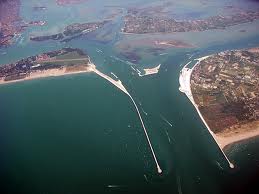Last week I went to a presentation at MIT made by a group of engineers that are half way through building a high technology barrier to protect Venice from rising waters. The project goes under the name MOSE (Moses).
Venice is a city built on an island situated in a lagoon that has been artificially shaped by human intervention over the last 500 years. The problem of rising sea levels and storms has meant that the city is regularly flooded, and so the project is to build a barrier spanning the three large openings to the lagoon so that it can be sealed in times of high tide and storms.
The flooding has been exacerbated by works carried out in the 1980’s and 90’s to build an industrial zone that involved the drainage of marshland areas, leading to a softening of the ground that made the city actually sink.
This is a 50 billion Euro project, and one of the biggest of its type ever attempted. A look at the data about the Thames Barrier (the first of its type) shows that the problem of high tides is getting worse. It was closed four times in the 1980s, 35 times in the 1990s, and 80 times since 2000, but why?
Strangely enough the problem is related to global temperature rise as we might imagine but not so much because of the melting of the icecaps. The fact is that water expands when it is heated so warming even by a couple of degrees has the effect of increasing its volume. The International Panel on Climate Change state that 70% of the presumed rise will be due to this factor.
So back to the barrier. The entire project is quite an undertaking as this YouTube video demonstrates. Years of planning followed by years of preparation, reclamation of marsh lands and sea defense construction not to mention the construction of an off shore oil terminal so that the ships no longer have to enter the lagoon. But Criticism is also rife.
Some engineers criticize the project on purely technical terms, other groups point to the lack of environmental impact study and others the cost.
This video also on YouTube tells a completely different story to the one above. Critics are arguing (amongst other things) that we do not know all of the variables involved (which seems to be true) and that the entire ecosystem of the lagoon will change.
I am no engineer so I cannot argue about the choices made, but I do have one simple question. With all of the movement of water involved in this project (serious high tides and the passage of thousands of liters of sea water a minute) would it not have been possible to build something that produced electricity instead of consuming it in huge amounts?
The stakes are high as you might imagine, Venice is one of the most touristed cities in the world, but the high tides are flooding the monuments ever more regularly. We are talking about more than a meter of water, and footage on international TV of tourists walking on raised platforms through St Mark’s Square and fresco covered churches full of water does not go down well.
It is an old problem though, and one that is shared by many cities today. New Orleans is discussing a similar solution, and here in Boston the issue is also under debate.
They are all looking for a high technology solution to an age old problem that is getting steadily worse.


